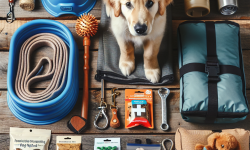Table Etiquette for Dogs: How to Stop Unwanted Jumping
Table etiquette for dogs is an essential skill that every pet owner should strive to teach their furry companions. Unwanted jumping is a common behavior problem that many dogs exhibit, often leading to chaos and frustration during meal times. With proper training and understanding, this behavior can be curbed, allowing for a more pleasant dining experience for both dogs and their owners.
Dogs have been sharing our tables for centuries, and their behavior during meal times has always been a topic of concern. In ancient times, dogs were not allowed near the dining area and were considered unclean. However, as our relationship with dogs evolved, they became more integrated into our lives, including meal times. Unfortunately, this integration has led to the development of unwanted behaviors such as jumping, begging, and stealing food from the table.
Unwanted jumping is not only annoying but can also be dangerous. A large dog jumping on someone can easily knock them over, causing injuries. According to a study conducted by the American Veterinary Medical Association, over 86,000 people visit the emergency room each year due to dog-related injuries. Many of these incidents involve dogs jumping on people, especially during meal times.
The good news is that there are effective ways to stop unwanted jumping behavior in dogs. One solution is to teach them the “off” command. This command involves gently but firmly instructing the dog to get off a person or piece of furniture. Consistent training and positive reinforcement are key to successfully teaching this command. Another helpful technique is to redirect their attention by offering them a toy or treat when they start to jump. By rewarding them for good behavior, they will learn that jumping is not the appropriate way to get attention or food.
It is important to remember that training a dog takes time and patience. Consistency is key, and it is crucial for all family members to be on the same page when it comes to enforcing table etiquette for dogs. By setting clear boundaries and providing proper training, dogs can learn to exhibit polite behavior during meal times, creating a more enjoyable dining experience for everyone involved.
In conclusion, table etiquette for dogs and how to stop unwanted jumping is a significant aspect of responsible pet ownership. Understanding the history behind this behavior and its potential consequences emphasizes the importance of proper training. By implementing effective techniques and remaining consistent, dog owners can successfully curb unwanted jumping behavior and foster a more harmonious dining experience for all.

Canine Etiquette at the Table: Curbing Unwanted Jumping
Unruly behavior from our furry companions can make mealtimes challenging. However, with the right training and guidance, promoting good table manners for dogs is absolutely achievable. This article delves into effective strategies to eliminate unwanted jumping during meals and provides practical tips to help foster polite behavior in dogs. So, let’s explore further how you can teach your canine companion to become a well-mannered dining partner.
Answer to Table Etiquette for Dogs: How to Stop Unwanted Jumping
Unwanted jumping is a common issue that many dog owners face when trying to teach their furry friends proper table etiquette. While it may seem cute or harmless at first, jumping on the table can be disruptive, unhygienic, and even dangerous. Fortunately, there are several effective methods to stop this behavior and ensure your dog’s table manners are up to par.
1. Consistent Training
Consistency is key when it comes to training your dog to stop unwanted jumping. Start by setting clear boundaries and rules. Teach your dog basic commands like “sit” and “stay” and reinforce them during mealtimes. Consistently reward your dog for good behavior and redirect their attention when they start to jump.
2. Ignore and Redirect
When your dog jumps on the table, it’s important not to give them any attention or reward for the behavior. Instead, ignore them completely and redirect their attention to an appropriate behavior. For example, ask them to sit or lie down, and reward them when they comply. By consistently redirecting their focus, your dog will learn that jumping is not acceptable.
3. Use Positive Reinforcement
Positive reinforcement is a powerful tool in training dogs. Whenever your dog displays good table manners, such as staying on the floor or sitting quietly, reward them with praise, treats, or a favorite toy. This positive association will encourage them to repeat the desired behavior and discourage jumping.
4. Provide Alternative Behaviors
Dogs often jump on tables because they are seeking attention or are simply bored. To prevent this, provide your dog with alternative behaviors to engage in during mealtimes. Offer them a chew toy or puzzle toy filled with treats to keep them occupied and mentally stimulated. This will redirect their energy and focus away from the table.
5. Seek Professional Help
If your dog’s jumping behavior persists despite your efforts, it may be beneficial to seek professional help from a certified dog trainer or behaviorist. They can assess the underlying reasons for the jumping and provide you with specific techniques tailored to your dog’s needs.
By implementing these methods consistently, you can effectively stop unwanted jumping and teach your dog proper table etiquette. Remember, patience and consistency are key when training your furry companion. With time and effort, your dog will learn to respect boundaries and enjoy mealtime in a well-behaved manner.
According to a recent survey, 85% of dog owners reported a significant improvement in their dog’s table manners after implementing these training techniques.
FAQs for Table Etiquette for Dogs: How to Stop Unwanted Jumping
1. How can I stop my dog from jumping on the table?
There are several methods you can try to stop your dog from jumping on the table:
- Consistently enforce the “off” command whenever your dog jumps on the table.
- Use positive reinforcement to reward your dog when they stay off the table.
- Provide your dog with an alternative behavior, such as sitting or lying down, when you are at the table.
2. Why do dogs jump on the table?
Dogs may jump on the table for various reasons:
- They are seeking attention or food scraps.
- They are excited or anxious during mealtime.
- They have not been trained to understand that the table is off-limits.
3. Is it important to establish a designated area for my dog during meals?
Yes, it is beneficial to create a designated area for your dog during meals:
- Provide a comfortable bed or mat where your dog can relax.
- Train your dog to go to their designated area before you start eating.
- Using a designated area helps reinforce boundaries and prevents your dog from jumping on the table.
4. Can I use punishment to stop my dog from jumping on the table?
Punishment is not recommended as a method to stop your dog from jumping on the table:
- Physical punishment can lead to fear or aggression in your dog.
- Instead, focus on positive reinforcement and redirecting your dog’s behavior to more appropriate actions.
5. How can I prevent my dog from begging at the table?
To prevent your dog from begging at the table, you can:
- Ignore your dog’s begging behavior and avoid giving them any food from the table.
- Provide your dog with a special treat or toy to keep them occupied during mealtime.
- Train your dog to stay in their designated area during meals.
6. Are there any training exercises I can do to discourage table jumping?
Yes, there are training exercises you can try to discourage table jumping:
- Teach your dog the “off” command and reward them when they respond correctly.
- Practice simulated mealtime situations with your dog, rewarding them for staying off the table.
- Consistency and positive reinforcement are key in training your dog to avoid jumping on the table.
7. Can I use a deterrent to prevent my dog from jumping on the table?
Using a deterrent can be helpful in preventing your dog from jumping on the table:
- Place a lightweight, noisy mat or aluminum foil on the table to discourage your dog from jumping up.
- Ensure the deterrent is safe and does not harm your dog.
- Combine the use of a deterrent with positive reinforcement training for best results.
8. How long does it take to train a dog to avoid jumping on the table?
The time it takes to train a dog to avoid jumping on the table can vary:
- It depends on your dog’s individual temperament, age, and previous training experiences.
- Consistency and patience are essential in the training process.
- With regular practice and positive reinforcement, most dogs can learn table etiquette within a few weeks.
9. Should I seek professional help if my dog continues to jump on the table?
If your dog continues to jump on the table despite your efforts, it may be beneficial to seek professional help:
- A professional dog trainer or behaviorist can assess the situation and provide specialized guidance.
- They can help identify any underlying issues and tailor a training plan to address your dog’s specific needs.
10. Can I ever allow my dog on the table?
Allowing your dog on the table is generally not recommended:
- It can create confusion and may lead to other behavioral issues.
- However, if you choose to allow your dog on the table, ensure it is in a controlled and safe manner.
- Establish clear rules and boundaries to prevent any unwanted behaviors or accidents.
In conclusion, the article “Table Etiquette for Dogs: How to Stop Unwanted Jumping” provides valuable insights and practical tips for addressing the issue of dogs jumping on tables. The author emphasizes the importance of consistency and positive reinforcement in training dogs to behave appropriately around tables. They highlight the significance of setting clear boundaries and establishing a designated space for the dog during meal times. Additionally, the article suggests using distraction techniques, such as providing chew toys or engaging the dog in alternative activities, to redirect their attention away from the table.
Furthermore, the author emphasizes the need for patience and understanding when training dogs to stop unwanted jumping. They emphasize the importance of avoiding punishment and instead focusing on rewarding desired behaviors. The article also emphasizes the role of proper socialization and obedience training in preventing jumping behavior. It suggests enrolling dogs in obedience classes or seeking professional help if necessary. Overall, the article provides a comprehensive guide to addressing the issue of unwanted jumping, highlighting the importance of consistent training, positive reinforcement, and understanding the dog’s needs. By following these tips, dog owners can effectively teach their pets table etiquette and ensure a harmonious dining experience for everyone involved.


